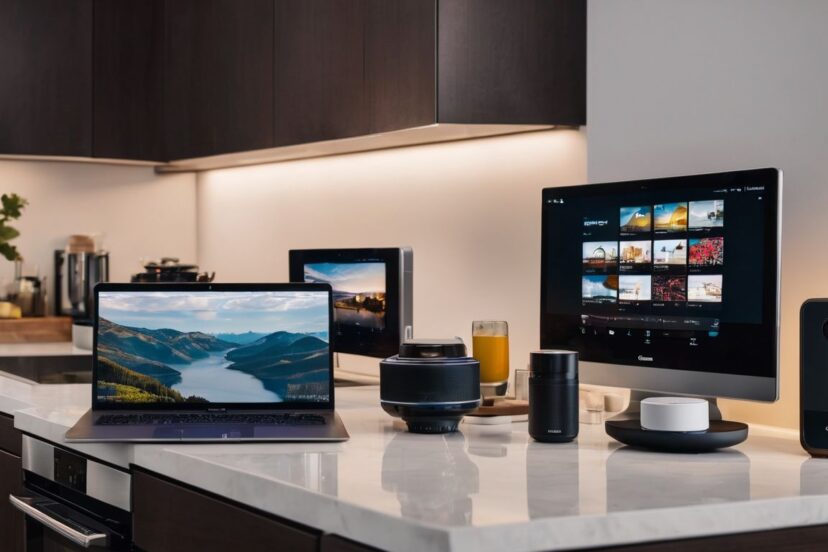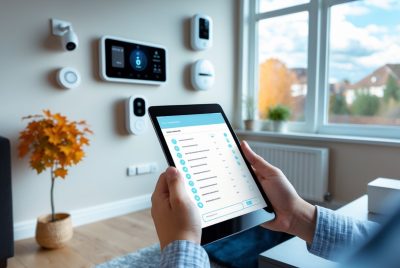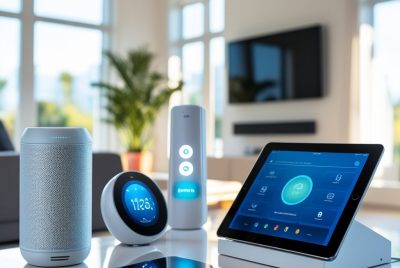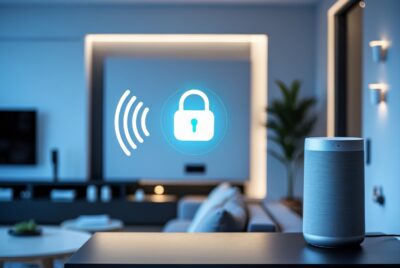Matter Smart Home Standard: Everything You Need To Know
*We may earn a commission for purchases made using our links. Please see our disclosure to learn more.
Matter Smart Home: Revolutionizing Modern Living Spaces
The smart home landscape can be confusing with numerous devices and standards, but Matter promises to simplify it all. Matter is a universal smart home standard supported by giants like Amazon, Apple, Google, and Samsung. This means devices that use Matter will work seamlessly together, making it easier for us to build and manage a smart home.

Matter-supported gadgets first became available in late 2022, and since then, new updates have continuously improved this standard. The introduction of Matter 1.3 brings exciting features like energy management and compatibility with more device types, making our homes smarter and more efficient.
Imagine controlling lights, locks, and thermostats from different brands without any hiccups. Matter aims to make this a reality, ensuring that every device integrates smoothly into our smart home ecosystem.
Understanding Matter Protocol

The Matter protocol aims to unify and simplify communication between smart home devices. This section covers its basic principles and development.
Basics of Matter
Matter is a connectivity standard for smart home devices. It focuses on interoperability, meaning devices from different brands can work together seamlessly. The protocol uses Internet Protocol (IP), enabling direct communication between devices and with cloud services.
Key features include:
- Universal Compatibility: Devices from various manufacturers can communicate.
- Security: Strong encryption to protect data.
- Ease of Use: Simplified setup and operation for users.
With these features, Matter seeks to reduce the fragmentation in smart home technology, making it more user-friendly and secure.
Evolution and Support
Since its inception, Matter has evolved to support a wider range of devices and functionalities. The initial version, Matter 1.0, included basic devices like lights and locks. The newer versions, such as 1.2 and 1.3, have expanded to support air conditioners, air purifiers, and robot vacuums.
Major tech companies like Google, Apple, and Amazon back Matter. Their support has accelerated its adoption and integration into various ecosystems. This broad support ensures users have a variety of compatible devices to choose from, enhancing their smart home experience.
By continually evolving and expanding its device support, Matter is positioned to become the standard for smart homes.
Matter-Compatible Smart Home Devices

Matter is a new smart home standard designed to unify devices across many brands. This means I can now use a wider range of gadgets seamlessly in my home, ensuring they work well together.
Categories of Devices
There are several types of devices that are now Matter-compatible. Smart lighting is a key category, with brands like Philips Hue offering bulbs and switches that can be easily integrated. Thermostats from companies like Ecobee and Nest also support Matter, allowing for more precise control over home temperatures.
Smart locks are another crucial category. Brands such as Schlage and Yale have introduced locks that connect seamlessly with other devices. Additionally, robot vacuums from makers like iRobot can now communicate with other Matter-enabled gadgets, making it easier to automate my cleaning routines.
Voice assistants, including Amazon Echo and Google Home, have also adopted Matter. This means they can control any Matter-enabled device, cutting through compatibility issues of the past.
Setting Up Matter Devices
Setting up Matter devices is straightforward. I start by ensuring I have a Matter-compatible hub, such as an Apple TV 4K or a Google Nest Hub. These hubs act as bridges to connect all my devices.
Once the hub is set up, I can add new devices using their specific apps. For example, I can use the Apple Home app for adding lights or thermostats, and they should integrate smoothly.
It’s also essential to keep my device firmware up to date. This ensures they can communicate effectively. Most updates can be done through the device’s app.
One final tip is to ensure my Wi-Fi network is robust, as many Matter devices rely on a stable internet connection to function correctly. This makes the overall setup process smoother and ensures all my devices remain connected.
Integrating Matter Smart Home With Your Devices

Setting up Matter in your home involves ensuring your network is ready and making sure your current devices can work with Matter-compatible gadgets.
Network Consideration and Setup with Matter Smart Home
First, I made sure my home network is stable. Matter needs a strong and consistent Wi-Fi signal. I checked that my router supports both 2.4 GHz and 5 GHz bands. This helps with better device connectivity.
Next, I secured my network. Using strong passwords and encryption helps protect my smart home from intrusions. I placed the Matter hub in the center of my home. This reduces any Wi-Fi dead spots.
Finally, I connected my devices. I followed specific pairing instructions, often scanning a QR code. Each device synced with the Matter network seamlessly.
Interoperability With Non-Matter Devices
I considered how my existing non-Matter devices would fit in. Many current smart home systems can still work with Matter through bridges or hubs. I used a compatible bridge to link older devices.
For example, I had a smart lock and light bulbs from different brands. Using a hub, I made sure they all communicated. This way, I didn’t have to replace all my devices. I checked compatibility lists. I found which of my older gadgets could work with Matter through software updates.
Addressing interoperability means I can continue using my favorite non-Matter gadgets efficiently. This approach helps make the transition to using Matter more seamless and cost-effective.
Developing for the Matter Smart Home Eco System

When developing for the Matter ecosystem, it’s important to focus on creating compatible accessories and utilizing the available software resources and documentation.
Developing Matter Accessories
As a developer, I need to ensure that all accessories I create are Matter-certified. This certification means my devices can work seamlessly with other Matter devices. To start, I should follow the guidelines provided by the Connectivity Standards Alliance, which includes specifics on hardware requirements and interoperability testing.
I might also want to consider user experience. For example, my accessories should be easy to set up and use, supporting smooth integration with popular platforms like Amazon, Apple, and Google. Ensuring that my devices send relevant notifications and updates will make them more user-friendly and reliable.
Software Resources and Documentation
I should make use of the various software resources and documentation available. The official Matter documentation provides detailed instructions on how to implement their standard protocols, including API references and code examples. Using these resources will help me reduce development time and avoid common pitfalls.
I can also leverage SDKs like Google’s Local Home SDK, which adds local fulfillment paths and simplifies the integration process. Additionally, joining community forums or developer groups can be valuable for troubleshooting and gaining insights from other developers working on similar projects.
By understanding and implementing best practices from these resources, I can create robust, interoperable products that meet industry standards.
Security and Privacy Features for Matter Smart Home

Matter Smart Home focuses on strong security measures and protection of user data. These features aim to ensure trust and safety for users.
Matter Security Model
Matter’s security model is robust. It uses encryption to keep communication between devices private. This means unauthorized access is prevented, making it hard for hackers to intercept data.
Each device must authenticate before joining the network. This step ensures that only trusted devices can connect.
Encryption and authentication make Matter a secure choice for your smart home.
User Data Protection
Protecting user data is critical with Matter. Personal information, like user settings and routines, is stored securely.
Access to data requires user consent. This keeps control in the user’s hands.
Additionally, device manufacturers must follow strict privacy guidelines. This ensures that data is not misused or shared without permission.
Providing strong protections helps build trust in the Matter Smart Home ecosystem.
Frequently Asked Questions
This section addresses common queries about integrating Matter-compatible devices, key features, supported devices, availability on Amazon, interoperability, and updates for existing smart hubs.
1. How do Matter-compatible devices integrate with Apple’s ecosystem?
Matter-compatible devices can easily integrate with Apple’s ecosystem. You can use the Home app on your iPhone or iPad to set up and control these devices. Setup often involves scanning a QR code or entering a code, making the process seamless and user-friendly.
2. What are the key features of the Matter smart home app?
The Matter smart home app simplifies device setup with user-friendly features like QR code scanning and numeric codes. It supports Bluetooth Low Energy for initial configuration. The app allows you to manage devices from different brands in one place, providing a cohesive and unified user experience.
3. Which devices currently support the Matter standard?
Several types of devices support the Matter standard, including smart bulbs, door locks, thermostats, sensors, and plug adapters. Major manufacturers such as Apple, Google, Amazon, and Samsung have endorsed Matter, ensuring broad compatibility and a wide range of available devices.
4. How does the Matter protocol ensure interoperability across different smart home brands?
Matter ensures interoperability through a unified communication standard. Devices from different brands can work together because they follow the same set of protocols and standards. This means you can mix and match devices from various manufacturers without compatibility issues.
5. Can existing smart hubs be updated to support the Matter protocol?
Yes, many existing smart hubs can be updated to support the Matter protocol. Updates may be available via firmware updates from the device manufacturer. This allows users to integrate their current smart home systems with new Matter-compatible devices without needing to replace existing hardware.




